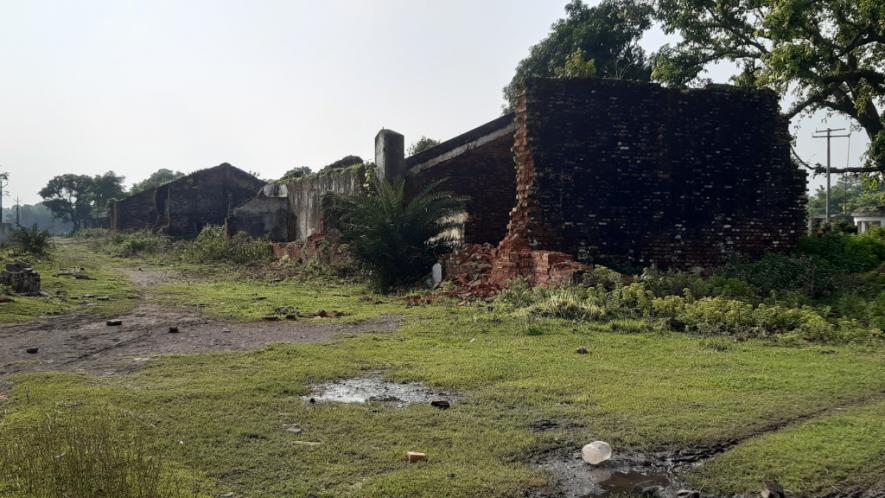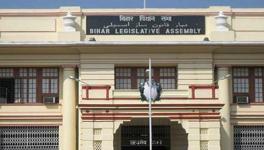Bihar Sugar Industry: Long Tale of Sweet Memories, Bitter Truth

Patna: Gone are the days when Bihar used to contribute 40% of the total sugar production of the country. It has now gone down to barely 4%. Thanks to the apathy of the Nitish Kumar-led state government, which, experts believe, has done nothing in the past 15 years to revive this industry except making hollow claims for electoral gains.
There were 33 sugar mills in Bihar before Independence. The number — according to the Sugarcane Development Department — has reduced to 28, of which 11 are operational and the rest 17 have been closed. Ten of the total functional mills are run by private managements.
Once a thriving industry, in the 1980s, it is now cited as an example of the state’s de-industrialisation.
FROM INDIGO TO SUGARCANE: A BRIEF HISTORY
Explaining the shift from indigo to sugarcane cultivation in North Bihar, Sunil Kumar Jha — who has written several research-based articles on the sugar industry in the state — said the East India Company had sent a delegation to India in 1792 with an aim to address the growing demand for sugar abroad.
To explore the possibilities of sugar production, the delegation, which came to India under the leadership of J. Peterson, said in its report that land in the Tirhut region of the erstwhile Bengal Presidency was not only suitable, but also had cheap labour and transport facilities.
“The area those days was known for indigo cultivation. Following the report, farmers in the region began growing sugarcane because profit in indigo production was less. As sugarcane cultivation began in the region, the first sugar mill was established in 1820 in Barah Estate of the Champaran region,” he told NewsClick.
The factory with a production capacity of 300 tonnes produced up to 8% of sugar from sugarcane juice. But people from the region did not even get to see the sugar produced here. It used to be sent to Western India, including Punjab, he added.
By 1877, indigo cultivation was reduced to 1,500 hectares from 5,000 hectares in the Western Tirhut region and sugarcane production began on 2,000 hectares. By 1903, farmers had abandoned indigo production forever.
ARRIVAL OF SUGAR MILLS
Jha said Tirhut got the taste of sugar only in the 20th century, when the factories were established here. Modern sugar mills were commissioned in the region after 1903. By 1914, sugar production started from Lohat and Raiyam sugar mills in Darbhanga district and Lauriya Sugar Mill in West Champaran.
Sugar factories in Siwan and Samastipur districts also became operational in 1918 and 1920, respectively.
In this way, a large unit of sugar production was established in the region. But these factories could not be developed with time due to the government’s neglect. Though these units witnessed some upgradation during the First World War, they were not at par with their foreign competitors.
By 1929, the industry began facing troubles and the number of sugar mills in the country came down to only 32, of which five were from the Tirhut region.
The health of the Tirhut sugar industry would not have deteriorated had the Indian Sugar Committee set up in 1920 made adequate recommendations for its preservation and upgradation. Later, the Imperial Agricultural Research Council recommended preservation of the sugar industry to protect the interests of sugarcane growers. As a result, the industry was given state support for the first time for seven years in 1932.
“Tirhut took full advantage of this opportunity, and the rapid development of this industry in the region stands testimony to this fact. Within four years, the number of sugar mills increased from seven to 17. As a result, sugar production increased six-fold and also the value of imported equipment increased eight-fold,” he continued and added, “Within six years of the state’s patronisation, sugar import decreased by Rs 8.5 crores, and sugar worth Rs 25 lakh was imported into India. The dividend paid by the sugar factories rose to 19.5% in 1932 and 17.2% in 1934 from an average of 11.2% between 1923 and 1931.”
Seeing this growth, Jha said, the Sugar Tariff Board in 1937 recommended state’s support to the industry for another two years. With the increasing productivity of sugar in Tirhut after the board’s recommendation was approved, India not only became self-sufficient in sugar production during 1938-39, but also began surplus production. The main reason cited was the protection given to the industry.
Drastic reduction in the cost of raw material and equipment after the Second World War, according to Jha, also proved helpful in the growth of the sugar industry in the region. But an international agreement in 1937 between 21 major sugar-producing countries of the world affected the industry. As per the agreement, an export quota for each country was fixed and India was banned for five years for exporting sugar to any other country. As a result, by 1942, the problem of over-productivity in the entire country, including Bihar, arose. This led to closure of many sugar mills.
ACQUISITION OF SUGAR MILLS BY GOVT
To counter the situation arising out of excessive production, sugar producers set up a union to prevent the depletion of product value. This association began to ensure the sale of sugar through its member factories. “By 1966-67, private mill owners of Bihar completely took control of the sugar industry and started adopting such a policy so that the government completely loses its control. This led to a conflict between sugar mill owners and the government,” said Jha.
In 1972, the Central government set up a sugar monitoring committee, which submitted its report to the government in the last week of 1972, explaining the condition and problems being faced by the industry. It suggested that the government acquire sugar factories.
Also read: Why A Ban on SDPI May Not Help BJP in Karnataka
As a result, from 1977 to 1985, the Bihar government acquired more than 15 sugar mills, which included Samastipur Central Sugar Cooperative Limited in Samastipur, Tirhut Cooperative Sugar Company Limited at Raiyam in Darbhanga district, Shital Sugar Works Limited at Goraul in Vaishali district, SKG Sugar Limited in Siwan district, Guraru Sugar Mill at Phanphar in Gaya district, New Siwan Sugar & Gur Refining Company, Darbhanga Sugar Company Limited at Lohat in Madhubani district, South Bihar Sugar Mill Limited at Bihta in Patna district, Sugauli Sugar Works Limited at Sugauli in East Champaran district, SKG Sugar Limited at Hathua in Gopalganj district, SKG Sugar Limited at Lauriya in West Champaran district, Motipur Sugar Factory at Motipur in Muzaffarpur district, Darbhanga Sugar Company Limited at Sakri in Madhubani district, Purnia Cooperative Sugar Factory Limited at Banmankhi in Purnia district, and Warisaliganj Cooperative Sugar Mill Limited at Warisaliganj in Nawada district.
COLLAPSE OF BIHAR’S SUGAR INDUSTRY
With an aim to run these sugar mills, Bihar State Sugar Corporation Limited was established in 1974 — which was supposed to control the losses of sugar mills and manage them smoothly. But most of these factories could not withstand the pressure of falling prices and increase in input costs. As a result, these units began closing one after another.
“After the crushing season of 1996-97, these factories were shut down. The deficit can be estimated from the fact that these factories owed Rs 8.84 crore to farmers and Rs 300 crore to their employees. By 1990, the sugarcane cultivation in the Tirhut, Mithila and Champaran regions was reduced to a few districts. It was replaced by wheat production, and the regions bid final adieu to sugarcane as a cash crop,” he told NewsClick.
NO REVIVAL, GOVT GIVES UP
To revive the closed mills, the government convened a high-level meeting in 2005 under the chairmanship of the Commissioner of the Sugarcane Industries Development. The committee in this meeting opined that a financial advisor should be appointed to revive and formulate a plan for the revival of the closed sugar factories under the Bihar State Sugar Development Corporation (BSSDC).
The SBI Capital was assigned this task. It gave a brief report to the state government on the basis of asset valuation, operational and financial parameters and proposed production of sugar at Raiyam, Motipur and Lohat. Rest of the closed mills were proposed to be developed into any viable industry other than sugar such as a food park or a dairy industry or a distillery at Sakri, a logistics park at Bihta and a jute mill at Samastipur.
Established with help of capital earned as profit from Lohat Sugar Mill in 1933, the sugar factory at Sakri was closed, as suggested by the financial advisor. In this way, Sakri became the first unit in the history of the sugar factories in Bihar which was closed forever.
Accordingly, the industries department invited a tender in 2008 and the Hindustan Petro Chemicals Limited (HPCL), a central government undertaking, secured the bids for the two sugar mills at Lauria and Sugauli after paying the bid money of Rs 95 crore It was backed by a project proposal of Rs 700 crore to produce methanol, power and sugar.
Following this, three separate tenders were floated by the department, which managed to secure bid money from interested investors for six other sugar mills. The bid money for Raiyam and Sakri plants stood at Rs 27.36 crore with project proposal of around Rs 200 crore. For Bihta and Motipur, it was Rs 79.40 crore and an investment proposal of Rs 350 crore. At Lohat and Samastipur, the bid money was Rs 58.71 crore.
“But these leases have so far not achieved the desired result of revival of the sugar factories. Shree Tirhut Industries Limited, which has got the Raiyam sugar mill on lease, has sold the old property of the mill instead of installing new machines. However, the company had claimed in 2009 that it would make the unit functional by 2010 with an investment of Rs 200 crore,” he said.
Of the total 13 sugar mills, which have been leased to private players, 11 factories that include Sugauli, Lauria, Bagha, Harinagar, Narkatiyaganj, Manjhaulia, Sasamusa, Gopalganj,, Sidhwalia, Riga, and Hasanpur have been made operational, while the future of Raiyam, Motipur and Lohat appear to be bleak despite going into private hands.
Finally, it appears that the government has now surrendered and accepted that it was unable to revive the closed mills. The government’s claim of controlling the deficit and managing it smoothly fell flat and proved to be false.
ETHANOL EMERGES AS BONE OF CONTENTION
Investors were less interested in sugar production, they wanted to get sugar mills for ethanol because the state government had envisaged that the prospective bidders would go in for independent production of ethanol. Accordingly, Bihar State Sugar Mills Act was amended in 2007 to facilitate independent production of ethanol.
Before the amendment got consent of the then President Pratibha Patil, then Union agriculture minister Sharad Pawar, fearing a large-scale shift from cultivation of food crops to cash crops, brought out the Cane Control Order that prohibited independent production of ethanol at sugar mills in the country. As a result, sugar acquired a bitter taste for investors.
ALL IS WELL
Bihar Cane Commissioner Uday Kumar Singh could not be reached for comments, but a senior officer in the Sugarcane Industries Department, not wishing to be named, said the government was doing everything possible for the revival of the industry.
“Things are improving. Raiyam, Motipur and Lohat sugar mills that have already been leased out will also start operating in the days to come. It takes time to bring things into order. Given the disinterest of investors, the revival of every closed sugar mill is not possible. The investors have been given options to develop Samastipur, Bihta and Sakri as any industry other than sugar because the government does not find it anachronistic,” he told NewsClick.
While discussing the closure of the 17 sugar mills in the state, he said, one often ignores silver linings. “With only 11 operational mills, the daily sugarcane crushing capacity has increased to over 81.50 lakh tonne in 2019-20. It is much higher than the days when all 28 mills were functioning. The sugar production in 2019-20 also witnessed a satisfactory growth of 8.56 lakh tonne. The sugarcane production in the state has witnessed a tremendous rise of 221 lakh metric tonne in 2019-20 from 183 lakh tonne in the previous year,” he said.
Also read: Why Small Cultivators Lose in Contract Farming Deals
Get the latest reports & analysis with people's perspective on Protests, movements & deep analytical videos, discussions of the current affairs in your Telegram app. Subscribe to NewsClick's Telegram channel & get Real-Time updates on stories, as they get published on our website.





















